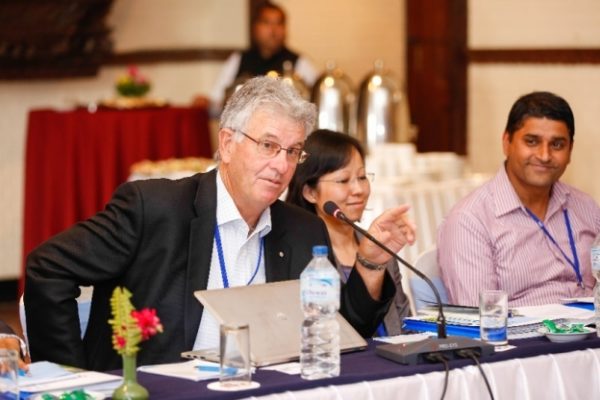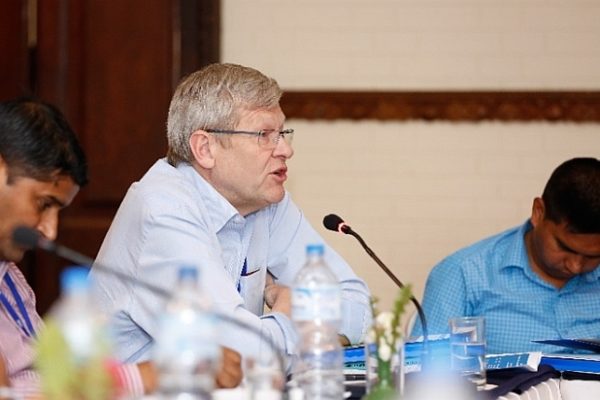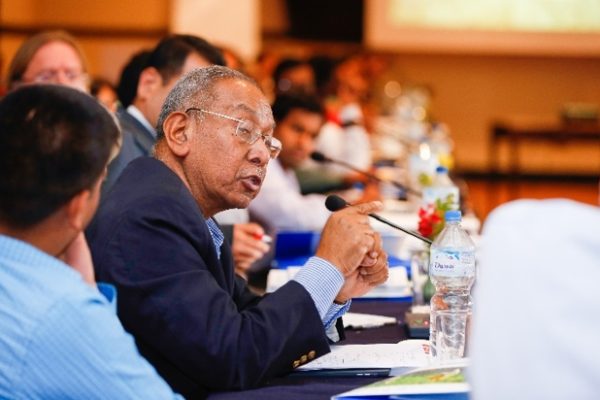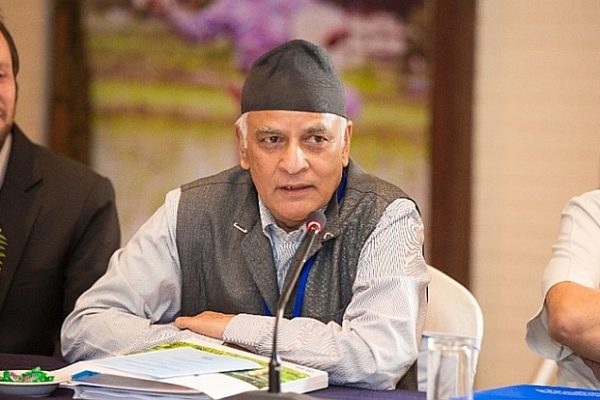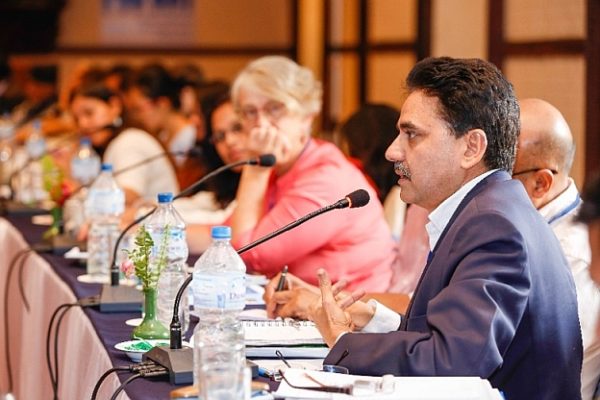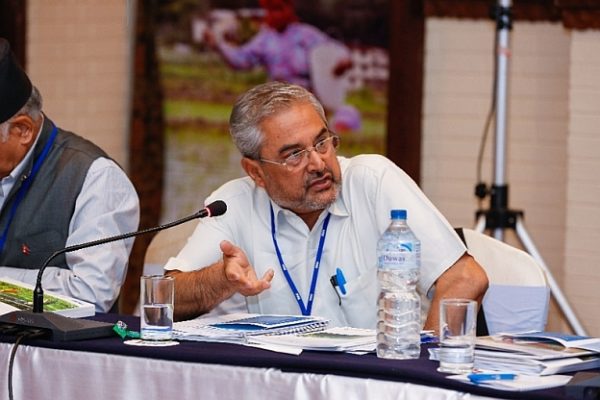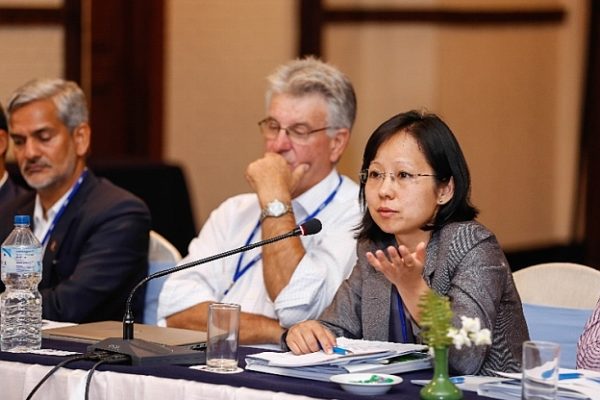High level policy dialogue organized by IWMI
(Kathmandu, 27 April) With over 6000 rivers flowing through it, Nepal has plenty of water. But natural challenges like earthquakes and a rugged mountainous terrain, combined with urbanization and extensive irrigation is reducing the availability of this precious resource. To discuss how the country can respond to this situation, a policy dialogue brought together national government officials, representatives of international development organizations in Nepal and the board of the International Water Management Institute (IWMI). Participants focused on the solutions and investments needed to sustainably manage water for food security and economic development.

Jeremy Bird, Director General of IWMI, started proceedings by welcoming the board and various partners and by inviting participants to share their views. He particularly asked how they felt IWMI’s research and partnering could help inform development choices in the country. Bird also highlighted that, with the recent signing of the new global agreement on climate change and finalization of the UN’s sustainable development goals, there are new opportunities for working in the water sector.
Global water Challenges
“We need to talk about the biggest single challenge that is going to face us in the next three decades: managing water”, said Donald Blackmore, IWMI Board Chair. “Water management is a crucial factor for food security. The key question is how we achieve that” he added.
One of the solutions identified by Blackmore was sustainable intensification of agriculture; producing more with what we have. Sharing some examples of successful efforts in various developing countries, he pointed out a couple of important things:

“Change doesn’t happen overnight, what we have to do is to get the preconditions in place and manage it progressively over time and have an adaptive management process,” he said.
He also highlighted the importance of groundwater for food security and the fact that the resource is not optimally utilized.
Nepal: Times of Change
Nepal is currently undergoing huge changes. These are having profound effects on the social and economic fabric of the country.
“Road access has improved and people have migrated,” noted Madhav Belbase, Joint Secretary, Ministry of Irrigation. “There are hardly any young people in the fields, there is nobody operating and maintaining irrigation systems”.
With outmigration of young people in search of greener pastures, a shift is taking place in the farming practices with more women in charge of smallholdings. They are farming whilst still having to undertake household chores, creating an excessive burden, added Fraser Sugden, interim head of IWMI’s office in Nepal.
A further challenge for the country is political. With the move towards federalization, new projects would have to face different water access challenges, and participants agreed that IWMI could play a role in promoting ways to equitably share water (or its benefits) amongst provinces.
“If federalization comes into the picture, water is going to be one of the contested issues amongst the three levels of government – local, provincial and federal. IWMI can help out with defining roles for the three levels of government,” noted Dwarika Nath Dhungel, an independent researcher.
Recovering from the massive earthquake last year has been not been an easy task for Nepal. The tremor caused a lot of damage to infrastructure, including irrigation infrastructure. Consequently, the monsoon has become all the more important to farmers, noted local irrigation expert Prachanda Pradhan. Citing overlap of water management institutions as one of the challenges facing those dealing with the aftereffects of the quake, Kabindra Pudasaini, Senior WASH Programme Coordinator, Wateraid added, “People don’t know who is responsible for managing irrigation systems. After earthquake 35-40% of water sources dried up. The biggest challenge is how to get drinking water to communities”
Storage, Storage, Storage
With a highly seasonal climate, water storage is a vital strategy for Nepal’s communities. Four types of water storage were highlighted by Dipak Gyawali, Director of the Nepal Water Conservation Foundation (NWCF). These include storage behind dams, groundwater, water harvesting structures and wetlands, “Dams are like lightning rods, inviting all kinds of reactions from everyone but water storage is something everyone is interested in,” he said, adding that IWMI should make storage a backbone of their advocacy efforts.
Temporal variability of water remains a major challenge facing Nepal, and this will be exacerbated by climate change. Water access is especially a challenge in the dry season. As Madhav noted, “With per capita availability of 8000 m³ per annum, there is no physical scarcity of water in Nepal. But when we talk of economic water scarcity, we don’t have enough physical infrastructure to provide water services, we don’t have water supply to mountain tops where people have been living for generations. So water scarcity is there because we don’t have enough infrastructure. If you have energy and pumps you can provide adequate water from river flow.”
Groundwater management and access is another constraint. “We have enough groundwater but there are other issues, a major problem being energy” said Madhav. “Electricity is not available both in terms of supply and voltage quality. Diesel is the reserve option, but we have to depend on India and sometimes there are supply problems and the costs are high”. The government is now focusing on solar pumps, he added, starting a new program next fiscal year based on shallow tubewells and pond rehabilitation. In the long term, the Nepal government is thinking of utilizing perennial rivers. It has already started projects involving inter basin transfer from perennial rivers to seasonal rivers and to supplement water to source rivers where irrigation systems are in place.
Finding Opportunities in Challenges
As Nepal looks at formulating its 14th National plan, planners will be developing sectorwise strategies for the next five years. Tripti Rai, Country Representative of Wateraid Nepal, asked the gathering, “Can we as a nation come together to think of a comprehensive water security framework? Something that helps look at the multiple demands for water.”
With climate change affecting both the supply side, which includes decrease in the river flows, and the demand side which implies increase in crop demand, Madhav asked IWMI to focus its research on what is likely to be the crop water requirement in future and how to construct irrigation systems that would meet future demands.
Climate Change and water are highly integrated, regional issues. Eklabya Sharma, Director of Program Operations at ICIMOD mentioned that they would like to see IWMI looking at water availability scenarios at local, basin and country level which can feed into national policies.
Cooperation at a regional level with neighboring countries like China, Bangladesh and India was another opportunity identified by the group. With the increasing complexities and critical challenges affecting water security in Nepal, the need and importance to translate research into practice and inform decision making was echoed by all stakeholders. SDG 6 on water was also identified as an opportunity for more action oriented research. With Nepal in the throes of multiple changes, the future of its water and food security will depend on how well these challenges can be converted into opportunities.


